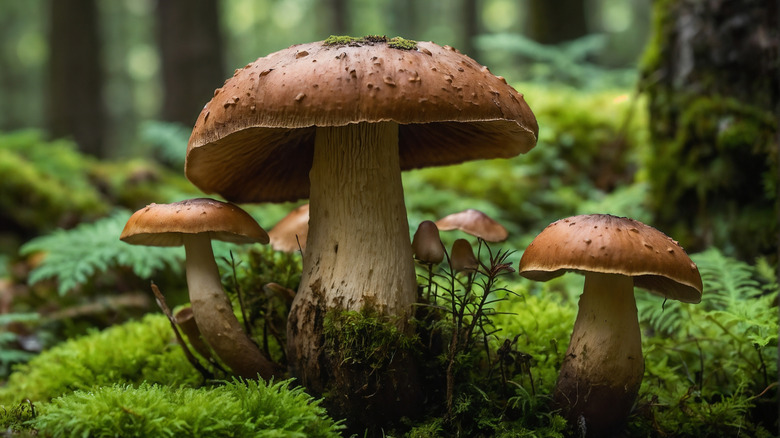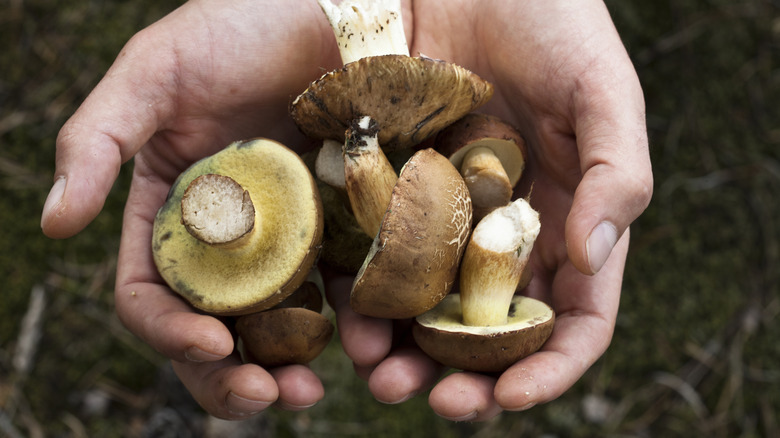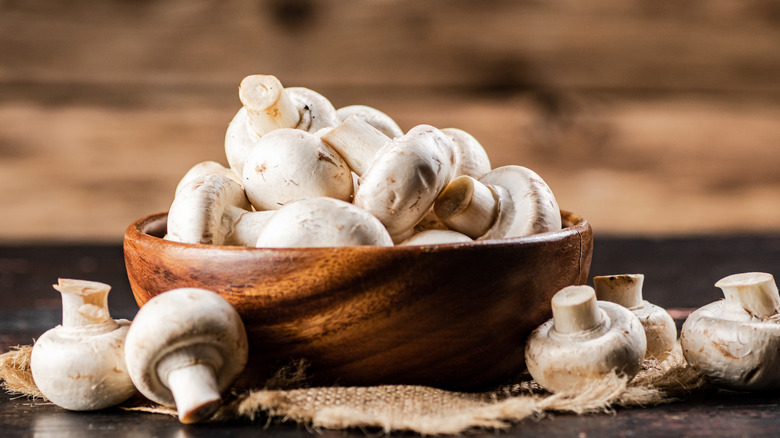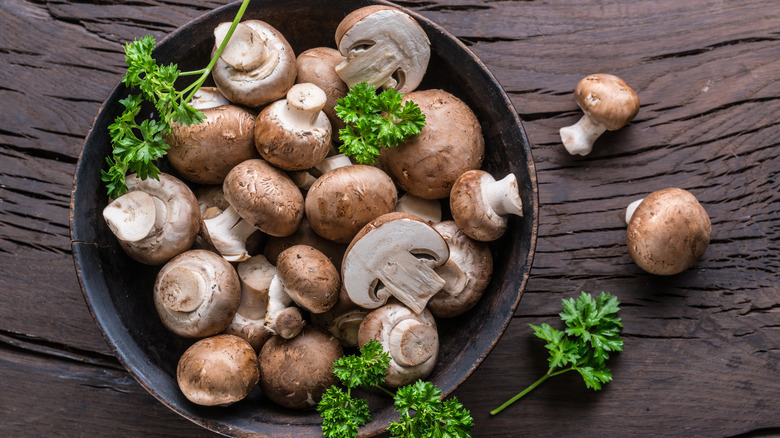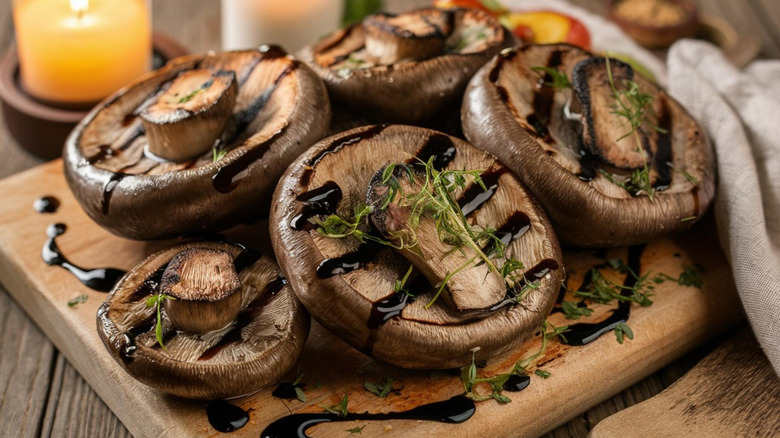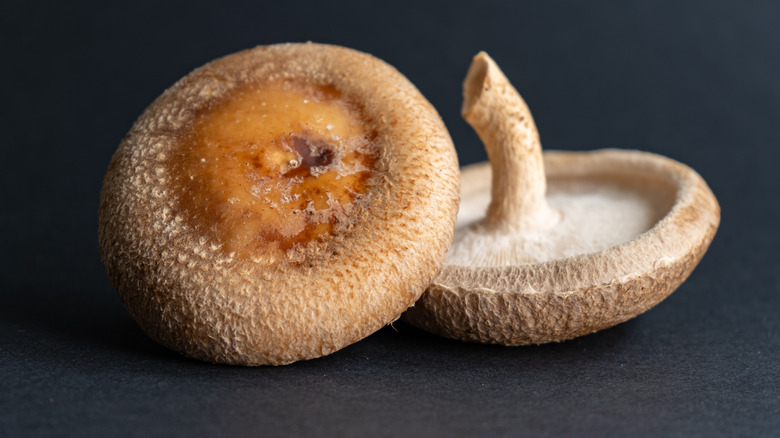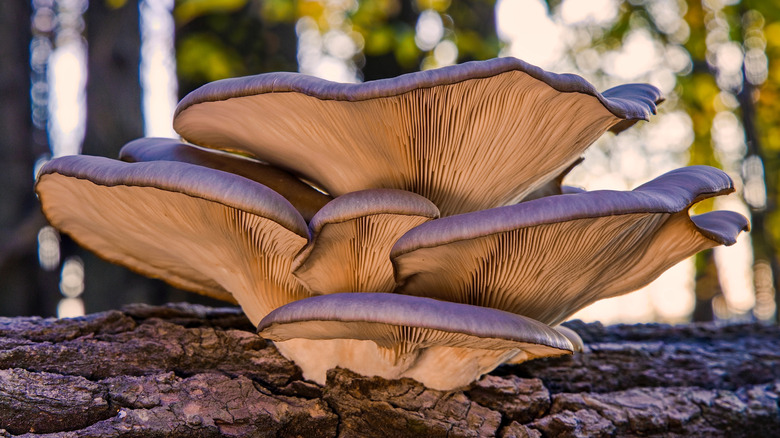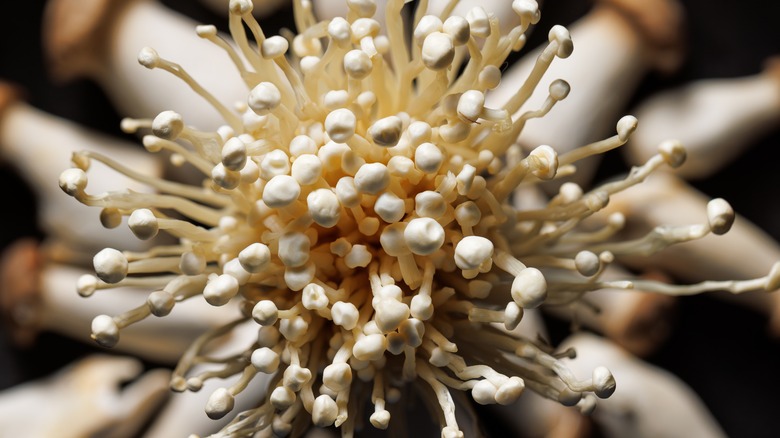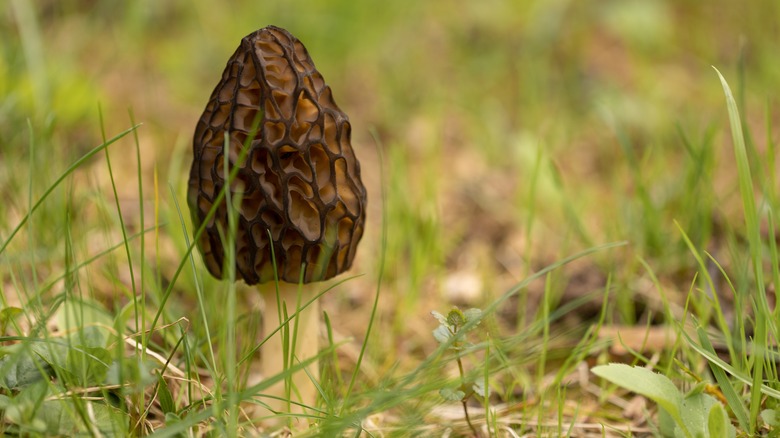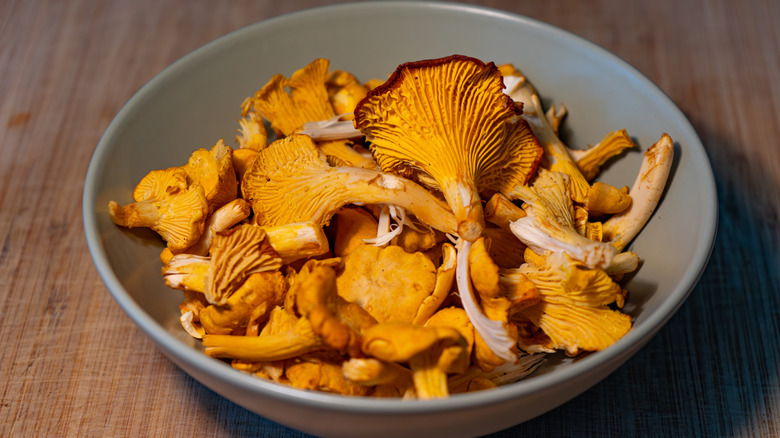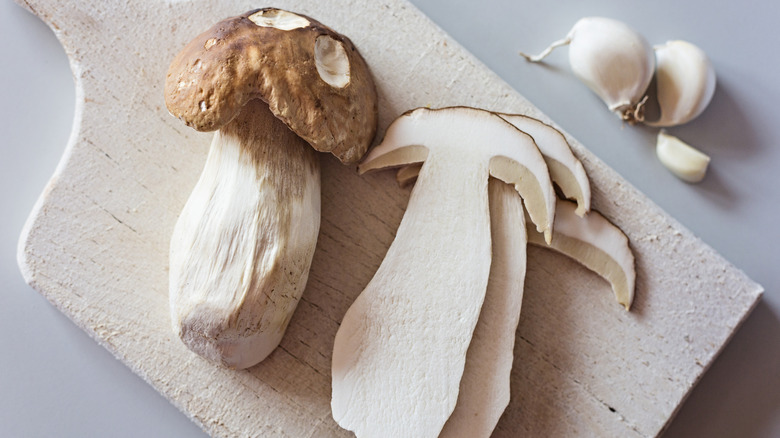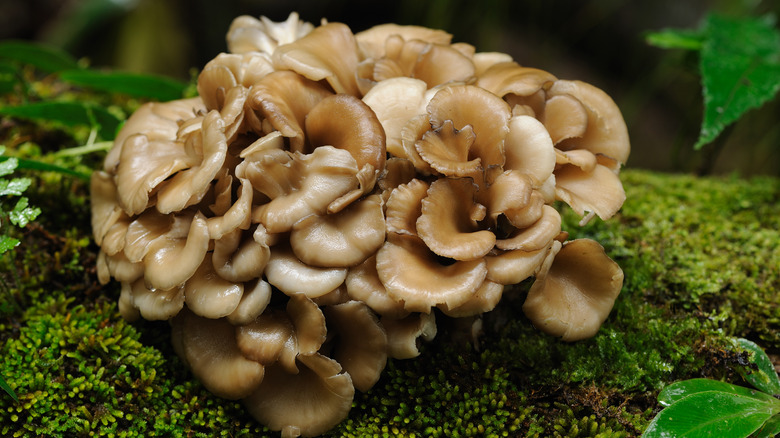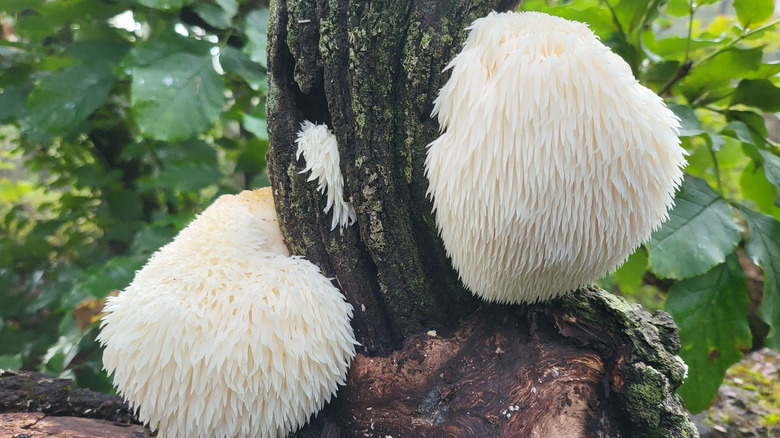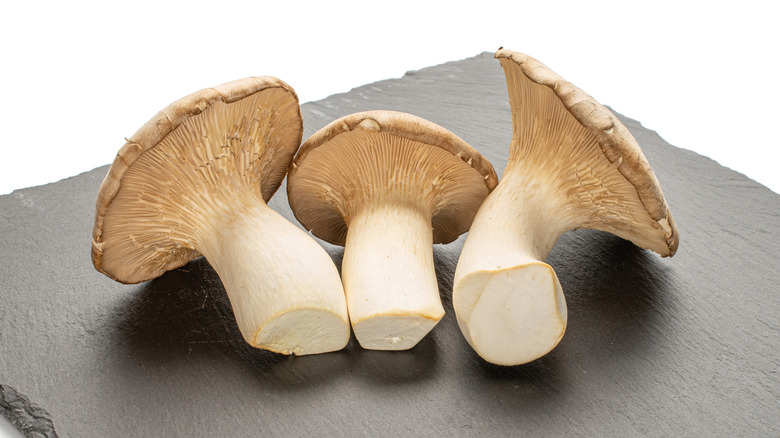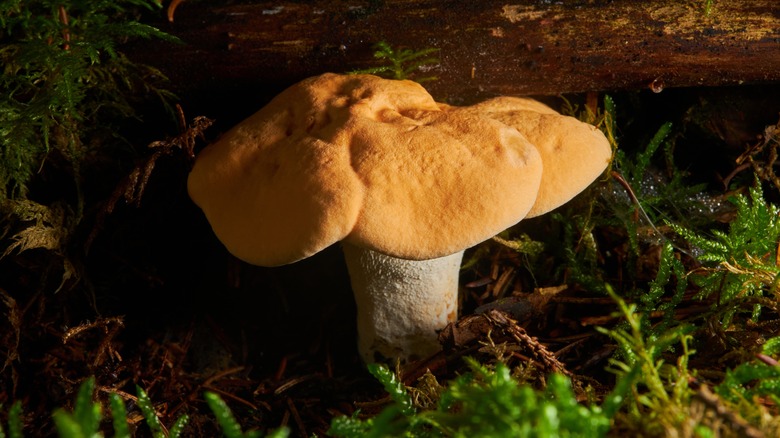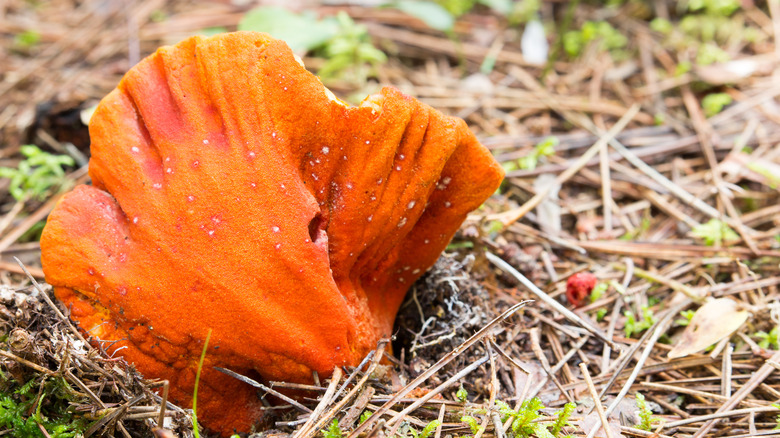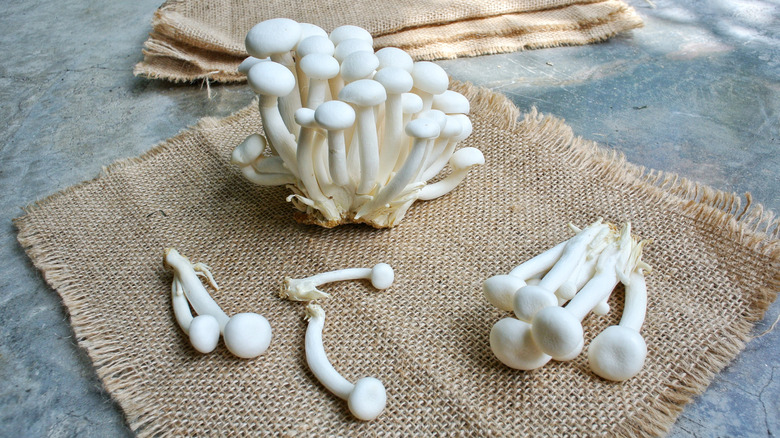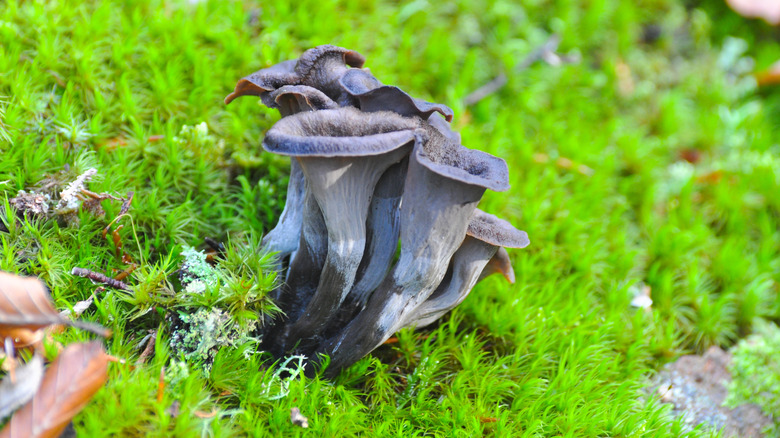16 Edible Mushroom Varieties And What To Do With Them
We may receive a commission on purchases made from links.
Mushrooms are fascinating. They have been around since prehistoric times and comprise around 14,000 species — roughly 2,200 are edible. Some mushrooms glow in the dark, others are hallucinogenic, while the world's most expensive is a parasitic form costing $63,000 per pound in 2023.
The range of shapes, colors and flavors has made mushrooms a must-eat food all over the world. For Sean Steller, director of business development of Pennsylvania-based Phillips Mushroom Farms, there are four key reasons why they are so enduringly popular. He said: "Mushrooms bring a savory umami flavor, making them versatile in cooking. Varieties like shiitake and portobello are especially prized for their rich, meaty taste."
They're a source of fiber, antioxidants, and vitamins, including vitamin D, and also low in calories, so we can pile 'em high on our plates. Their benefits don't end there, as Steller explained: "Mushrooms are the natural recycler, utilizing waste products from other industries to generate wonderful and diverse varieties. Mushrooms can be used in a wide range of cuisines, from Italian to Asian, in soups, stews, stir-fries, and even as a meat substitute." Sounds like they're good in just about everything! Let's take a closer look at 16 edible mushroom varieties and what we can do with them.
All about mushrooms
According to The Nutrition Source, mushrooms are a form of fungus that are generally "distinguished by a stem, fleshy rounded cap, and gills underneath the cap." Harvesting is increasingly popularand millions of people head into the great outdoors to forage for wild mushrooms. There are lots of rules enforced by the USDA in the United States
Of course, finding mushrooms in the wild is one thing, knowing whether they're going to make you sick is quite another. Luckily, lots of expert guidance can keep you safe. Treehugger focuses on some of the most toxic, while "Beginner's Guide to Safely Foraging for Wild Mushrooms" is great for newbies.
Every kind of mushroom can be stored the same way. Remove plastic packaging from store-bought mushrooms and pop them in a plain brown bag or wrap them in a tea towel before putting them in the refrigerator. Unsliced, they will keep for up to seven days in a fridge, compared to one or two days for sliced ones. You can also freeze mushrooms or dry them and put them in an airtight container to extend their shelf-life.
Button mushrooms (Agaricus bisporus)
Also known as the common or white mushroom, champignon de Paris, and table mushroom, button mushrooms are popular pretty much everywhere. The majority are grown in Europe, South-east Asia and North America, and this relatively humble variety accounts for 85% of the 50,000 tonnes produced per year.
Sean Steller, director of business development of Pennsylvania-based Phillips Mushroom Farms, said: "These are the most common mushrooms found in grocery stores and come in a variety of different sizes based on maturity. [They] pair well with herbs like thyme, rosemary, and garlic. A little bit of soy sauce or balsamic vinegar can add extra depth."
Their mild, slightly sweet flavor and robust texture makes the button mushroom the perfect addition to a wide range of dishes. Slice them for a quick and healthy pizza topping, toss a handful into a veggie curry to give it more texture, or add them to stir-fry for an unmistakable umami boost.
Cremini mushrooms (Agaricus bisporus)
Cremini come from the same family as button mushrooms, and are also known as brown, baby portobello, baby bellas, and Italian mushrooms. They have brown caps and are often slightly bigger than their button cousins, simply because they are white mushrooms that are a little older.
Alongside having more of the ergothioneine antioxidant that makes them good for us, their maturity means cremini have a firmer texture and a deeper flavor: Good news for home cooks using them in dishes (and, of course, you'll want to avoid these mistakes). If you want a step up from the humble button mushroom, you should give these a whirl too.
The next time you're rustling up a rich risotto, add some cremini and they will infuse it with their nutty and earthy taste. They are ideal for roasting because they keep their shape better, and will pep up a salad. Cremini can even hold their own in a punchy marinade.
Portobello Mushrooms (Agaricus bisporus)
Known variously as portabella and portabello, as well as cappellone or Roman mushroom, the Portobello is a hit with Sean Steller, director of business development of Pennsylvania-based Phillips Mushroom Farms. "A brown version of the agaricus bisporus mushroom, they have excellent umami flavor. Marinate portabella mushrooms and grill them as a vegetarian main or burger substitute," he suggested.
Portobello mushrooms are the fully grown versions of the button variety, with a deeply earthy, umami flavor. Apart from tasting delicious, they have lots of health benefits, including anti-inflammatory and antioxidant properties. Studies have shown portobello mushrooms can help prevent cancer cells from spreading and cut the risk of mild cognitive impairment in seniors.
Portobello mushrooms are a super-flexible food too. Remove the stem, chop it finely and mix it with cheese, herbs and garlic for the best oven-baked stuffed mushroom, or just grill it and slap it between two burger buns for a 100% veggie version of the evergreen fast food.
Shiitake Mushrooms (Lentinula edodes)
The alternative names for shiitake sound ominous, but whether you know it as the Chinese black, black forest, brown oak or black winter, they're all delicious. More than 80% of shiitake mushrooms come from Japan, and they are the world's second most-popular variety after button mushrooms.
Dark brown with a flattish cap and slender stem, when cooked they taste earthy, with an aroma that evokes woodland. Dried shiitake have an intensely umami flavor, and both forms are widely used by home cooks and chefs. However, eating raw shiitake can lead to toxic flagellate dermatitis, a whole-body skin reaction that can last for around three weeks.
Thoroughly cooking your shiitake mushrooms will destroy the lentinan toxin responsible for the rash. They can be stuffed and baked, like portobello mushrooms, roasted in the oven for a crispy snack, or you can use shiitake to add depth to a hearty vegetable soup.
Oyster Mushrooms (Pleurotus ostreatus)
With their fan-like shapes and strange clusters, there is something otherworldly about the oyster mushroom. Perhaps that's why it's also known as angel's wings, abalone mushroom or the tree oyster? Sean Steller, director of business development at Phillips Mushroom Farms, who admires their delicate texture and mild taste, explained that Phillips Mushroom Farms is always testing new varieties for their customers, and successfully introduced a pink oyster mushroom in 2024.
They come in a range of other colors too, from blue and yellow to brown and were initially grown as a ration food during the WWI. Today the oyster mushroom has grown to become a staple of Chinese and Japanese cooking, bringing its complex – almost briny flavor – to a range of delicious dishes. Slice and sprinkle them raw to bring a velvety twist to a crisp green salad, or maximize their meaty flesh by grilling, barbecuing or pan-searing them whole in a little butter. Yum!
Enoki Mushrooms (Flammulina velutipes)
Possibly the prettiest of all mushroom types, enoki are also called winter mushrooms, winter fungus, enokitake, and futu. Wild varieties are shorter and darker than cultivated enoki but both have clusters of long, slender stems topped by a round cap.
Enoki mushrooms don't just look unusual: They have less flavor than other fungi but that doesn't mean they're not worth your culinary time. These smart 'shrooms take on the taste of whatever dish they are part of, enhancing the whole.
They are also incredibly practical and can be microwaved, steamed, deep fried, sautéed, boiled, and baked; cooking in just a few moments. That flexibility makes enoki an ideal addition to a range of dishes. Separate them and toss them in a salad, or pop a cluster of enoki in a bowl of instant warming ramen. If you want to freeze them, make sure to trim off the base and separate the strands first.
Morel Mushrooms (Morchella elata or esculenta)
"Specialty mushrooms stand out because of their unique flavors, textures, and even potential health benefits," said Sean Steller, mushroom expert at Phillips Mushroom Farms. None more so than the morel mushroom, aka morchella, whose difficulty to grow and short harvesting season makes them rare and highly prized.
Steller added: "Specialty mushrooms generally are grown using different substrate and growing conditions than the more common White/Portabella varieties." With its thick stem and honeycombed dome, the morel is easy to recognize (though don't confuse it with the toxic Gyromitra esculenta) and, like shiitake, can make you sick if eaten raw.
Cooked morels have a subtle, earthy and nutty taste, while the darker the cap, the smokier the flavor. The aroma of baked bread, so closely associated with this mushroom, intensifies during the cooking process. Morels are a superb accompaniment to meat, make a great ravioli filling and are delicious when lightly tossed in flour and then pan-fried.
Chanterelle (Girolle) Mushrooms (Cantharellus cibarius)
Of all the names for this funnel-shaped mushroom (which include golden or yellow chanterelle and egg mushroom) "pfifferling" has to be the cutest. Their rich, yellow-orange color makes them easy to spot in the wild and the supermarket — but that's not the only thing to love about them.
Like the morel, chanterelles are hard to grow commercially and not available all year round, so they are highly sought after. Chanterelle mushrooms are fleshy and have a silky mouthfeel, with a flavor profile taking in everything from pepper and hazelnut to apricot. They can be cooked in several ways, though they do contain a lot of water so dry pan-frying is among the preferred methods.
Many chefs envelop their chanterelles in rich sauces loaded with butter and cream, but take care not to overwhelm this prized mushroom's flavor. Alternatively, dry them out to ensure you have a long-term supply in your store cupboard.
Porcini Mushrooms (boletus edulis)
In France, cepe mushrooms are regarded as a noble or luxury product, and rightly so. Also called Borowik, Polish mushrooms, bolete and king bolete, porcini comes from the Italian for "little pigs," and dates back to Roman times. These mushrooms have bulbous white stems and a large, flattened brown cap, and are much sought-after by foragers across the northern hemisphere.
Porcini are chunky and meaty, with a smooth texture and an intense, umami-yet-earthy flavor. It's so powerful that even dried versions still pack a hefty culinary punch when rehydrated, making them beloved by home cooks who can't get hold of fresh 'shrooms.
Although popular among gastronomes, porcini are amazing in even the most simple dishes. Add depth to a hearty stew with a handful of dried porcini, use them to give a savory twist to your homemade tomato sauce or, as Sean Steller, Phillips Mushroom Farms, suggests, let them shine in a creamy, comforting dish of risotto.
Maitake Mushrooms (Grifola frondosa)
Chinese and Japanese foodies have loved maitake mushrooms for generations. Now sheepshead, ram's head, dancing mushroom, and hen-of-the-wood are grown in the United States and Europe too. Although they look similar to shiitake and oyster varieties, maitake mushrooms have distinct frilly tops and grow in feather-like clusters.
When it comes to flavor, both wild and cultivated maitake are in a league of their own. Sometimes described as bold, the earthy, peppery taste marks this mushroom out from other varieties. Unlike the relatively delicate oyster, maitake has a fleshy, robust texture that can withstand cooking at a high temperature and still look and taste amazing.
So, that's a big tick for roasting or sautéeing maitake mushrooms — but they bring a flavor boost to other dishes too. Offer a new lease of peppery life to a bowl of leftover ramen or soup, or throw in a handful to bring oomph to a beef stew.
Lion's Mane Mushrooms (Hericium erinaceus)
Looking more like Cousin Itt than a lion, this quirky lil' fella is also known as bearded hedgehog, yamabushitake, and bearded tooth fungus. It grows across North America and Eurasia, and is part of the tooth fungus family, which means the parts carrying the spores hang down from the cap.
Lion's mane mushrooms have a distinct, earthy aroma with a flavor often described as nutty and sweet, while some insist they taste like seafood. They're one of the firmer and fleshier mushroom varieties, making them the perfect alternative to meat for many dishes.
Sean Steller, mushroom expert at Phillips Mushroom Farms, said lion's mane crab cakes were a favorite among his customers, but these mushrooms can also be added to baked goods such as homemade bread or cakes. They will give a subtle twist to veggie quiches or pies, or you can slosh them with a little olive oil and grill them for a crispy treat.
King Trumpet Mushrooms (Pleurotus eryngii)
They may look a bit like porcini but the king trumpet mushroom has a few differences. First, it's called the boletus of the steppes, eryngi, and French horn mushroom, among many other names. Second, unlike porcini, it has gills on the underside of the cap, because the king trumpet is the biggest of the oyster variety.
Like the lion's mane, the king trumpet has a seafood quality and looks like scallops when those thick stems are cut into rounds. This meaty mushroom is another favorite among vegetarians, thanks to its solid texture and cooking flexibility.
They can be easily sliced lengthways to add nutty, earthy interest to a green salad, or chopped up and swirled in a hot pan with garlic, herbs and butter for a sizzling side. Those chunky stems? Perfect for shredding on top of your weeknight tacos – but for Sean Steller, director of business development of Pennsylvania-based Phillips Mushroom Farms, a creamy mushroom soup really lets the king trumpet's earthy flavor sing.
Hedgehog Mushroom (Hydnum repandum)
Another member of the tooth fungus family, the hedgehog mushroom also goes by hedgehog fungus, Pied de mouton (that's French for sheep's foot), and wood hedgehog.
These fungi range in color from cream to pink-orange, and can be found across the United States and Europe, growing up to 8 inches tall in the same boggy, woody conditions favored by chanterelles. Hedgehog mushrooms have a fruity aroma while their firm texture turns chewy after cooking –they are beloved among foodies.
Hedgehog mushrooms are delicious when stirred into broths and soups, while Sean Steller, mushroom expert at Phillips Mushroom Farms, recommends sautéing them in butter or oil with garlic and thyme. They can also bring depth and a burst of umami goodness to tomato and cream-based sauces. Slip them into a meat pie or a sizzling stir-fry to boost your veggie intake, or why not use a pickle or brine to preserve your hedgehog mushrooms?
Lobster Mushrooms (Hypomyces lactifluorum)
In Mexico, this is known as the "tromba de puerco" or pork horn — but don't be fooled by the name. The lobster mushroom is actually the product of a parasite, created when Russula or Lactarius mushrooms are infected and transformed by Hypomyces lactifluorum.
They are gnarlier-looking than other varieties, with irregular-shaped caps. However, their orange-to-red color makes them easy to spot when foraging. As the name suggests, lobster mushrooms have a mild seafood smell, yet their flavor is a combination of fruity, sweet and nutty. Dried versions intensify both aroma and taste, and will keep for years if stored out of the sun in a sealed container.
Their firm texture allows them to hold their shape when cooked, and in Mexico they are fried or boiled before being added to tortillas. Lobster mushrooms are excellent in baked pasta, curries and soups, or you can chop them into a paste and spread them on toast.
Hon Shimeji Mushrooms (Hypsizygus tessulatus)
Also known as the tomo-motachi, brown beech, buna-shimeji, and beech, this tiny but mighty mushroom packs both a visual and culinary punch. Hon shimeji mushrooms come in white and brown varieties and, like enoki, grow in clusters with long stems topped by round caps.
While white hon shimeji taste mild and sweet, their brown counterparts are noted for their nutty flavor, though they have also been described as bitter and buttery. The base of the mushroom where the stems join is not edible but the rest is a delicious treat for 'shroom-loving foodies.
Hon shimeji mushrooms may look delicate and, as long as you don't overcook them, they're pretty robust. They will withstand boiling, baking and sautéing at medium-high heat without too much trouble. Add them alongside peppers and scallions for a healthy stir-fry, or use them to give a unique twist to an Indian-inspired meal.
Black Trumpet Mushrooms (Craterellus cornucopioides)
With pseudonyms including horn of death and trompette de la morte, you could be forgiven for giving this one a wide berth. But black trumpet mushrooms are also known as the horn of plenty, and have lots of health benefits.
Found across North America, Europe, and Asia, they are quite fragile and feel rather soft. Chef Alan Bergo described their smell as "... dark and intensely sweet aroma of apricots that are nearly overripe." Often compared to truffles, he said the black trumpet's flavor was "a sort of a rich, earthy, oddly sweet and fruity taste that will remind you of fresh apricots and ripe stone fruit, with a bitter note at the end."
Black trumpet mushrooms may be delicate but they make up for it with their intense taste. Fresh, dried or powdered, they will elevate even the best plate of scrambled eggs or bring umami luxury to a warming bowl of risotto.
